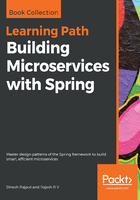
What this book covers
Chapter 1, Getting Started with the Spring Framework 5.0 and Design Patterns, gives an overview of the Spring 5 Framework and all new features of the Spring 5 Framework, including some basic examples of DI and AOP. You’ll also get an overview of the great
Spring portfolio.
Chapter 2, Overview of GOF Design Patterns - Core Design Patterns, gives an overview of the Core Design Pattern of the GoF Design Patterns family, including some best practices for an application design. You'll also get an overview of the common problems solving with design patterns.
Chapter 3, Wiring Beans using Dependency Injection Pattern, explores dependency injection pattern and detail about the configuration of Spring in an application, showing you various ways of configurations in your application. This includes a configuration with XML, Annotation, Java, and Mix.
Chapter 4, Spring Aspect Oriented Programming with Proxy and Decorator Pattern, explores how to use Spring AOP to decouple cross-cutting concerns from the objects that they service. This chapter also sets the stage for later chapters where you'll use AOP to provide declarative services such as transactions, security, and caching.
Chapter 5, Accessing Database with Spring and JDBC Template Patterns, explores how to access the data with Spring and JDBC; here, you’ll see how to use Spring's JDBC abstraction and JDBC Template to query relational databases in a way that is far simpler than native JDBC.
Chapter 6, Improving Application Performance Using Caching Patterns, shows how to improve application performance by avoiding the database altogether if the data needed is readily available. So, I will show you how Spring provides support for caching data.
Chapter 7, Implementing Reactive Design Patterns, explores the Reactive Programming Model, which is programming with asynchronous data streams. You'll see how the Reactive System is implemented in the Spring Web Module.
Chapter 8, Implementing Concurrency Patterns, takes a closer look at concurrency when handling multiple connections inside a web server. As outlined in our architectural model, request handling is decoupled from application logic.
Chapter 9, Demystifying Microservices, gives you an introduction to microservices. This chapter covers the background, evaluation, and fundamental concepts of microservices.
Chapter 10, Related Architecture Styles and Use Cases, covers the relationship with Service-Oriented Architecture, the concepts of cloud native and Twelve Factor applications, and explains some of the common use cases.
Chapter 11, Building Microservices with Spring Boot, introduces building REST and message-based microservices using the Spring Framework and how to wrap them with Spring Boot. In addition, we will also explore some core capabilities of Spring Boot.
Chapter 12, Scale Microservices with Spring Cloud Components, shows you how to scale previous examples using Spring Cloud stack capabilities. It details the architecture and different components of Spring Cloud and how they integrate together.
Chapter 13, Logging and Monitoring Microservices, covers the importance of logging and monitoring aspects when developing microservices. Here, we look at the details of some of the best practices when using microservices, such as centralized logging and monitoring capabilities using open source tools and how to integrate them with Spring projects.
Chapter 14, Containerizing Microservices with Docker, explains containerization concepts in the context of microservices. Using Mesos and Marathon, it demonstrates next-level implementation to replace the custom life cycle manager for large deployments.
Chapter 15, Scaling Dockerized Microservices with Mesos and Marathon, explains auto-provisioning and deployment of microservices. Here, we will also learn how to use Docker containers in the preceding example for large-scale deployments.